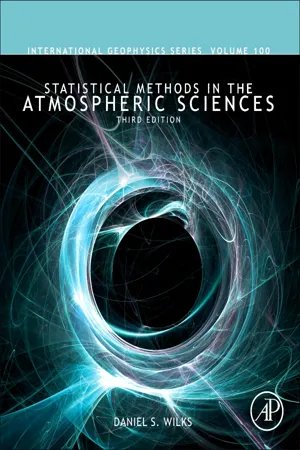
- 704 pages
- English
- ePUB (mobile friendly)
- Available on iOS & Android
Statistical Methods in the Atmospheric Sciences
About This Book
Statistical Methods in the Atmospheric Sciences, Third Edition, explains the latest statistical methods used to describe, analyze, test, and forecast atmospheric data. This revised and expanded text is intended to help students understand and communicate what their data sets have to say, or to make sense of the scientific literature in meteorology, climatology, and related disciplines.
In this new edition, what was a single chapter on multivariate statistics has been expanded to a full six chapters on this important topic. Other chapters have also been revised and cover exploratory data analysis, probability distributions, hypothesis testing, statistical weather forecasting, forecast verification, and time series analysis. There is now an expanded treatment of resampling tests and key analysis techniques, an updated discussion on ensemble forecasting, and a detailed chapter on forecast verification. In addition, the book includes new sections on maximum likelihood and on statistical simulation and contains current references to original research. Students will benefit from pedagogical features including worked examples, end-of-chapter exercises with separate solutions, and numerous illustrations and equations.
This book will be of interest to researchers and students in the atmospheric sciences, including meteorology, climatology, and other geophysical disciplines.
- Accessible presentation and explanation of techniques for atmospheric data summarization, analysis, testing and forecasting
- Many worked examples
- End-of-chapter exercises, with answers provided
Frequently asked questions
Information
Table of contents
- Cover
- Contents
- Series Editors
- Copyright
- Preface to the Third Edition
- Preface to the Second Edition
- Preface to the First Edition
- Chapter 1 Introduction
- Chapter 2 Review of Probability
- Chapter 3 Empirical Distributions and Exploratory Data Analysis
- Chapter 4 Parametric Probability Distributions
- Chapter 5 Frequentist Statistical Inference
- Chapter 6 Bayesian Inference
- Chapter 7 Statistical Forecasting
- Chapter 8 Forecast Verification
- Chapter 9 Time Series
- Chapter 10 Matrix Algebra and Random Matrices
- Chapter 11 The Multivariate Normal (MVN) Distribution
- Chapter 12 Principal Component (EOF) Analysis
- Chapter 13 Canonical Correlation Analysis (CCA)
- Chapter 14 Discrimination and Classification
- Chapter 15 Cluster Analysis
- Appendix A Example Data Sets
- Appendix B Probability Tables
- Appendix C Answers to Exercises
- References
- Index